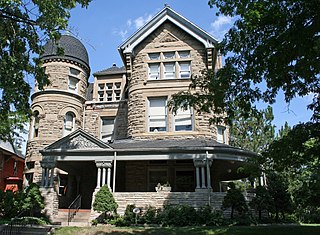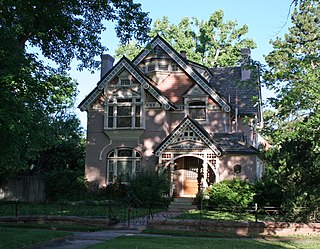Colfax Avenue is the main street that runs east–west through the Denver metropolitan area in Colorado. As U.S. Highway 40, it was one of two principal highways serving Denver before the Interstate Highway System was constructed. In the local street system, it lies 15 blocks north of the zero meridian, and would thus otherwise be known as 15th Avenue. The street was named for the 19th-century politician Schuyler Colfax. At just over 50 miles in length, it is known as the "longest continuous commercial street in America."

The Molly Brown House Museum is a house located at 1340 Pennsylvania Street in Denver, Colorado, United States that was the home of American philanthropist, activist, and socialite Margaret Brown. Brown was known as "The Unsinkable Molly Brown" because she survived the sinking of the RMS Titanic. The museum, now located in her former home, presents exhibits interpreting her life and that of Victorian Denver as well as historic preservation. The house was listed on the National Register of Historic Places in 1972. It is designated as a Denver Landmark.

The Denver Civic Center is a civic center area that includes two parks surrounded by government and cultural buildings and spaces. Civic Center is located in central Denver, Colorado, on the south side of Downtown Denver. Much of the area is a historic district which was listed on the National Register of Historic Places in 1974. A somewhat smaller area was designated a U.S. National Historic Landmark in 2012 as one of the nation's finest examples of the City Beautiful movement of civic design. Denver Civic Center lies partially within the north end of an official Denver neighborhood also named Civic Center. It includes the Colorado State Capitol building, in the west end of Denver's official Capitol Hill neighborhood, and it includes a few buildings in the south end of Denver's Central Business District.

Washington Park is a neighborhood and public urban park in Denver, Colorado. The Washington Park located in Denver, Colorado, United States is a blend of historic and contemporary styles of architecture. Its historic buildings, lakes, tennis courts, lawns, large flower gardens, and recreation center provide various experiences for visitors. The park was first developed by Architect Reinhard Scheutze in 1899. Its design was influenced by city planner Kessler, the Olmsted Brothers and the famous philanthropist “The Unsinkable” Molly Brown. The park is very popular both as a tourist destination and among Denver locals, with some comparing it to New York City's Central Park. Apart from activities like jogging, walking or biking, the park serves as a center for social activities and encourages community involvement. Due to its welcoming appearance and unique characteristics, the Washington Park was designated as one of the “Great Public Spaces in America” by the American Planning Association in the year 2012.

City Park is an urban park and neighborhood in Denver, Colorado. The park is 330 acres (1.3 km2) and is located in east-central Denver. The park contains the Denver Zoo, the Denver Museum of Nature and Science, Ferril and Duck Lakes, and a boathouse. City Park is also the name of the neighborhood that contains the park, though the park is the vast majority of the neighborhood. To the immediate north of the park is the City Park Golf Course. City Park is the largest park in Denver.

The Paramount Theatre is a concert venue in Denver, Colorado, located on Glenarm Place, near Denver's famous 16th Street Mall. The venue has a seating capacity of 1,870 but is a popular destination for large acts looking for a smaller concert setting. With spelling as Paramount Theater, the building was listed on the National Register of Historic Places in 1980.

Cheesman Park is an urban park and neighborhood located in the City and County of Denver, Colorado, United States.

The Bailey House was built in 1889, and was designed by William A. Lang. The Bailey House, built for a Mr. G.W. Bailey, is the largest of William Lang's surviving residential residences. William A. Lang (1846–1897) was a Denver architect who was active from 1885 to 1893.
Frederick Sterner (1862–1931) was a British-born American architect, who designed large residential and commercial buildings in Colorado and New York City. Many of his structures are listed on the National Register of Historic Places.

The Frederick W. Neef House is a house in Denver, Colorado, United States that was built in 1886 and is listed on the U.S. National Register of Historic Places.

William A. Lang (1846–1897) was an architect active in Denver, Colorado from 1885 to 1893. On his own or in partnership he designed a number of buildings that survive and are listed on the U.S. National Register of Historic Places. Lang partnered with Marshall Pugh to form Lang & Pugh in 1889. The firm also employed Reinhard Schuetze for a time.

William Ellsworth Fisher was an architect who founded the Denver, Colorado firm that became Fisher & Fisher.

Burnham Hoyt was a prominent mid-20th-century architect born in Denver, Colorado.

Manitou Springs Historic District in Manitou Springs, Colorado is roughly bounded by US 24, Ruxton Avenue, El Paso Boulevard and Iron Mountain Avenue. Listed in the National Register of Historic Places, it is one of the country's largest National Historic Districts.
Merrill H. Hoyt was a prominent American architect, business man and leader in the building design community of Denver, Colorado from 1910 to 1933.

Flower-Vaile House is a historic house in North Capitol Hill, Denver, Colorado. The house was designed by Balcombe and Rice and built by D. S. Gray. It was designated a Denver Landmark on October 13, 1981 and was listed on the National Register of Historic Places on October 21, 1982. Richard R. Brettel described the house in Historic Denver as a prime example of "decorative or surface style eclecticism added to the basic Queen Anne Street house — very common in Denver by the mid- to late-1880s."
The Tilden School for Teaching Health operated from 1916 to 1931 as a private residential teaching institution and sanitarium that offered patients an alternative to the standard medical practices of the day. Located in Denver, Colorado, the school was established to teach and promote the medical theories of its founder, Dr. John Henry Tilden.

The Dickinson Branch Library, at 1545 Hooker St. in the West Colfax neighborhood of Denver, Colorado, is a Carnegie library which was built in 1914. It was listed on the National Register of Historic Places in 2002.

The Nathaniel W. Duke House, at 1409 Craig St. in Pueblo, Colorado, was built in 1889. It was listed on the National Register of Historic Places in 1985.

The Galligan House, at 501 Colorado Ave. in Pueblo, Colorado, is a Queen Anne-style house which was built in 1891 for a prominent Pueblo lawyer. It was listed on the National Register of Historic Places in 1982.
















